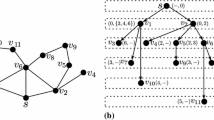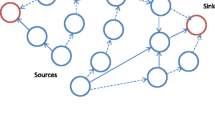Abstract
Wireless Sensor Networks (WSNs) have many characteristics that are attractive to a myriad of applications. In particular, nodes employ multi-hop communications to collaboratively forward sensed data back to one or more sinks. In this context, reducing the end-to-end delay between the sink and sensor/source nodes is of interest to many applications. In particular, those that require a fixed, upper bound on end-to-end delays. To this end, we focus on bounding the end-to-end delay from the sink to each source. We first formulate the problem as a Binary Integer Program (BIP). As the problem is NP-hard, this paper proposes and studies two centralized, heuristic algorithms: Tabu and Domino. The key approach used by both algorithms is to determine the minimal number of extra wake-up slots required by a given network in order to ensure the delay of all end-to-end paths is within a given bound. We conducted two sets of experiments. The first set compares BIP, Tabu, and Domino in WSNs with up to 80 nodes. These experiments serve to compare the proposed algorithms against BIP, which become computationally expensive in large scale WSNs. The results show that, compared to BIP, the number of additional wake-up times generated by Tabu and Domino are within 5 and 10 % of the optimal solution. In the second set of experiments, which evaluates the algorithms in WSNs with 100–500 nodes, the average number of extra wake-up slots activated by Domino is 13 % greater than Tabu. These algorithms have a time complexity of \({\mathcal {O}} (\alpha n^2 T + n^3)\) and \({\mathcal {O}}(n^3)\) respectively, where \(n\) is the number of nodes, \(T\) is the number of slots in one period, and \(\alpha\) is the maximum number of iterations carried out by the Tabu algorithm.























Similar content being viewed by others
Notes
BIP is one of Karp’s 21 NP-complete problems.
References
Akyildiz, I., Su, W., Sankarasubramaniam, Y., & Cayirci, E. (2002). Wireless sensor networks: a survey. Computer Networks, 38(4), 393–422.
Cao, Q., Abdelzaher, T., He, T., & Stankovic, J. (2005, April). Towards optimal sleep scheduling in sensor networks for rare event detection. In IPSN LA, USA.
Chalasani, S., & Conrad, J. (2008). A survey of energy harvesting sources for embedded systems. In IEEE Southeastcon (pp. 442–447). Hunstville, AL, USA.
Du, S., Saha, A., & Johnson, D. (2007). Rmac: A routing-enhanced duty-cycle mac protocol for wireless sensor networks. In 26th IEEE international conference on computer communications (pp. 1478–1486). Scotland.
Dutta, P., & Culler, D. (2008). Practical asynchronous neighbor discovery and rendezvous for mobile sensing applications. In Proceedings of the 6th ACM conference on embedded network sensor systems (pp. 71–84). Raleigh, USA.
Gu, Y., & He, T. (2010). Bounding communication delay in energy harvesting sensor networks. In 30th IEEE international conference on distributed computing systems (ICDCS) (pp. 837–847). Genoa, Italy
Gu, Y., He, T., Lin, M., & Xu, J. (2009). Spatiotemporal delay control for low-duty-cycle sensor networks. In 30th IEEE real-time systems symposium (pp. 127–137). Washington, USA.
Gu, Y., Zhu, T., & He, T. (2009). Esc: Energy synchronized communication in sustainable sensor networks. In 17th IEEE international conference on network protocols (pp. 52–62). New Jersey, USA.
Han, C., Kumar, R., Shea, R., & Srivastava, M. (2005). Sensor network software update management: A survey. International Journal of Network Management, 15(4), 283–294.
Hong, S., & Kim, H. (2009). A multi-hop reservation method for end-to-end latency performance improvement in asynchronous mac-based wireless sensor networks. IEEE Transactions on Consumer Electronics, 55(3), 1214–1220.
IBM. (2012). Ibm ilog cplex optimization studio interfaces. http://www-01.ibm.com/software/integration/optimization/cplex-optimizer/interfaces/interactive_optimizer.
IEEE. (2012). Ieee802.15.4. http://www.ieee802.org/15/pub/TG4.html.
Kansal, A., Hsu, J., Zahedi, S., & Srivastava, M. (2007). Power management in energy harvesting sensor networks. ACM Transactions on Embedded Computing Systems (TECS), 6(4), 32.
Keshavarzian, A., Lee, H., & Venkatraman, L. (2006). Wakeup scheduling in wireless sensor networks. In ACM MOBICOM (pp 322–333). LA, CA, USA.
Lang, X. Bounding end-to-end delays in energy harvesting wireless sensor networks. http://ro.uow.edu.au/cgi/viewcontent.cgi?article=4677&context=theses.
Li, Y., Ye, W., & Heidemann, J. (2005). Energy and latency control in low duty cycle mac protocols. In IEEE wireless communications and networking conference (Vol. 2, pp. 676–682). New Orleans, USA.
Lin, P., Qiao, C., & Wang, X. (2004). Medium access control with a dynamic duty cycle for sensor networks. In IEEE Wireless Communications and Networking Conference (WCNC) (Vol. 3, pp. 1534–1539). Hungary.
Lu, G., Krishnamachari, B., & Raghavendra, C. (2004). An adaptive energy-efficient and low-latency mac for data gathering in wireless sensor networks. In Proceedings of 18th international parallel and distributed processing symposium (p. 224). Massachusetts, USA.
Lu, G., Sadagopan, N., Krishnamachari, B., & Goel, A. (2005). Delay efficient sleep scheduling in wireless sensor networks. In INFOCOM Miami, FL, USA.
Maroti, M., Kusy, B., Simon, G., & Lédeczi, A. (2004). The flooding time synchronization protocol. In Proceedings of the 2nd international conference on embedded networked sensor systems (pp. 39–49). Baltimore, MD, USA.
Mathworks. Matlab—the language of technical computing. http://www.mathworks.com/products/matlab.
Nazir, B., & Hasbullah, H. (2011). Dynamic sleep scheduling for minimizing delay in wireless sensor network. In Saudi international electronics, communications and photonics conference (SIECPC) (pp. 1–5). Egypt.
Salarian, H., Chin, K., & Naghdy, F. (2012). Coordination in wireless sensor-actuator networks: A survey. Journal of Parallel and Distributed Computing, 72(7), 856–867.
Scheinerman, E. R. (2008, March). Matgraph: A matlab toolbox for graph theory. http://www.ams.jhu.edu/ers/matgraph/matgraph.pdf.
Starner, T. (1996). Human-powered wearable computing. IBM Systems Journal, 35(3–4), 618–629.
Sun, Y., Du, S., Gurewitz, O., & Johnson, D. (2008). Dw-mac: A low latency, energy efficient demand-wakeup mac protocol for wireless sensor networks. In ACM MOBICOM (pp. 53–62). San Francisco, USA.
Taneja, J., Jeong, J., & Culler, D. (2008). Design, modeling, and capacity planning for micro-solar power sensor networks. In IPSN (pp. 407–418) Missouri, USA.
Vasanthi, N., & Annadurai, S. (2006). Aws: Asynchronous wakeup schedule to minimize latency in wireless sensor networks. In IEEE international conference on sensor networks, ubiquitous, and trustworthy computing (Vol. 1, pp. 7). Taiwan.
Wang, X., Wang, X., Xing, G., & Yao, Y. (2010). Dynamic duty cycle control for end-to-end delay guarantees in wireless sensor networks. In 18th international workshop on quality of service (IWQoS) (pp. 1–9). Beijing, China.
Yang, X., & Vaidya, N. (2004). A wakeup scheme for sensor networks: Achieving balance between energy saving and end-to-end delay. In Proceedings of 10th IEEE on real-time and embedded technology and applications symposium (pp. 19–26). Hong Kong.
Yoo, H., Shim, M., & Kim, D. (2012). Dynamic duty-cycle scheduling schemes for energy-harvesting wireless sensor networks. IEEE Communications Letters, 16(99), 1–3.
Yun, D., Yoo, S., Kim, D., & Kim, D. (2008). Od-mac: An on-demand mac protocol for body sensor networks based on ieee 802.15. 4. In 14th IEEE international conference on embedded and real-time computing systems and applications (pp. 413–420). Taiwan.
Acknowledgments
We thank the reviewers for their excellent comments, which have improved the presentation of our paper significantly.
Author information
Authors and Affiliations
Corresponding author
Rights and permissions
About this article
Cite this article
Lang, X., Chin, KW. Algorithms for bounding end-to-end delays in Wireless Sensor Networks. Wireless Netw 20, 2131–2146 (2014). https://doi.org/10.1007/s11276-014-0729-7
Published:
Issue Date:
DOI: https://doi.org/10.1007/s11276-014-0729-7




